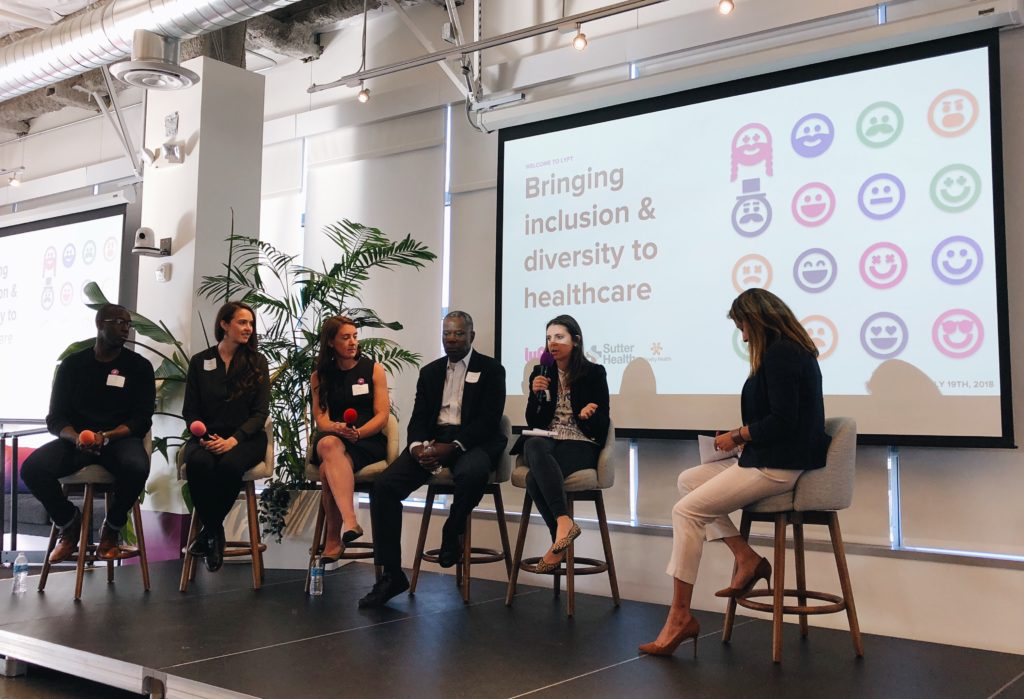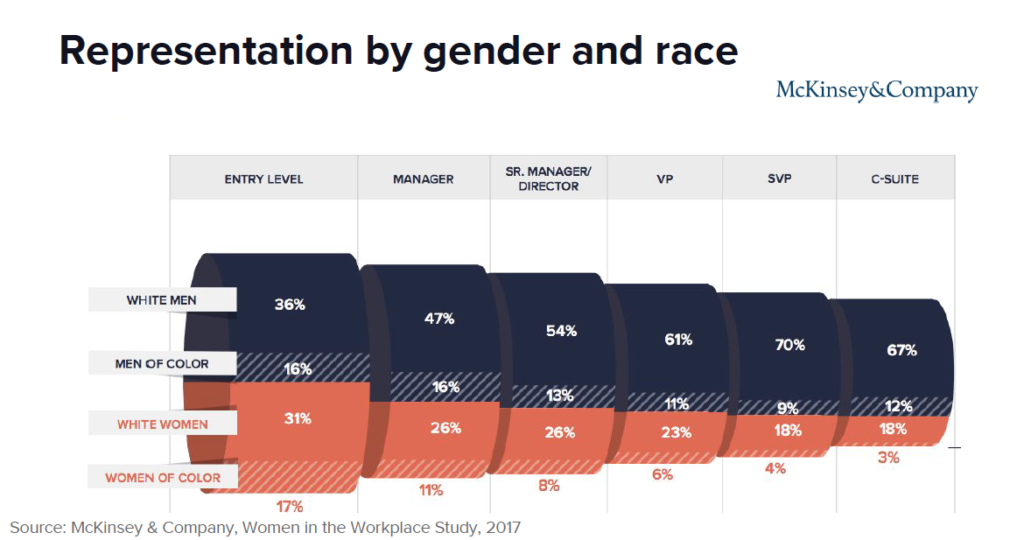Four steps you can take to bridge healthcare’s diversity gap—starting today
While awareness about diversity has grown, the healthcare industry has moved at a glacial pace to bridge the gap. To help turn awareness into action, senior leaders from Lyft Healthcare, Rock Health, Sutter Health, and Dignity Health had a conversation to provide actionable steps that individuals at all levels can take to immediately address and diminish the diversity gap in the workplace.

From left to right: Kevin Ige, Account Manager of Healthcare Solutions at Lyft; Katie Simpson, Director of Innovation & Strategic Partnerships at Sutter Health; Courtney Baker, Senior Healthcare Field Account Executive at Lyft; Darryl Robinson, Chief Human Resources Officer at Dignity Health; Megan Zweig, Director of Research at Rock Health; and Veronica Juarez, Senior Director of Enterprise Initiatives at Lyft
The status quo
To provide a jumping off point for the discussion, Lyft’s Veronica Juarez presented McKinsey & Company’s 2017 Women in the Workplace cross-industry report, illustrating the stark decline in diversity as individuals progress through their careers. Among entry level positions, women occupy nearly half of all roles. But by the time people reach senior management and leadership levels, the proportion of white men increases at a staggering rate, with this group occupying 67% of C-suite positions. Meanwhile, the percentage of women in the C-suite decreases to 21%—with women of color occupying a mere 3% of C-suite roles.
Narrowing the scope to just the healthcare industry reveals a similar story: within Fortune 500 healthcare companies, the percentage of women at the executive and board level has remained stagnant, hovering around 22% since 2015.
Working 24/7 gets rewarded at the C-suite level, but the pathway to get there is limiting for people with family responsibilities or health difficulties. Our obligation is to enact change—by looking at what we reward and thinking about how that may filter individuals out on the way up.
Katie Simpson, Director of Innovation & Strategic Partnerships, Sutter Health
Why is addressing the diversity gap important?
In healthcare, it is particularly critical to ensure decision makers better reflect and represent the diversity of the patient populations they’re serving. According to Dignity Health’s Darryl Robinson, promoting diversity and inclusion at all levels of an organization fosters empathy and allows for better decision-making. He noted, “The most optimal solutions come from allowing everyone to have a seat at the decision-making table. This gives everyone a voice and provides equal representation.”
Apart from promoting a positive work culture, cultivating inclusion supports the bottom line. One study shows that companies with racial diversity in the top quartile of their industry are 35% more likely to have better financial returns compared to the industry national median. And gender-balanced teams (between 40-60% ratio of male to female) are 23% more likely to see an increase in gross profit as compared to teams dominated by one gender. When we looked at the percentage of women in leadership positions at Fortune 500 healthcare companies, we found companies with higher percentages of women executives are more highly rated by employees.
It’s important to recognize the path to true inclusion begins long before the C-suite. Lyft’s Kevin Ige highlighted that promoting underrepresented groups to positions of leadership provides youth from marginalized backgrounds with role models they can connect with from an early age. Robinson echoed this sentiment by reiterating the importance of early childhood experiences and the need to nurture our nation’s youth through access to quality education. To cultivate diversity across all organization levels, it’s crucial to provide every available opportunity to youth to become a part of the applicant pool from which leadership is drawn down the line.
What can we do to enact change?
It’s not just about the “why”—importantly, the panelists also shared practical tips to combat the persisting diversity gap.
1. Encourage sponsorship and advocacy at all levels.
Dignity Health’s board of directors consists of 13 members—six of whom are women and six of whom are people of color. In fact, the last two Board Chairs have been women of color, a rarity in boardrooms across the nation. Robinson pointed out this is a direct result of executive leadership advocating for diversity and making these organizational decisions a priority. Given that 49% of Dignity’s employees are of color, Robinson sets the expectation that women and people of color represent a fair and equal percentage of candidates under consideration for any job opportunity at Dignity Health.
If you want to change the data, you need an advocate—otherwise, people will follow the path of least resistance. In my experience, this has to start at the top for the gain to take root.
Darryl Robinson, Chief Human Resources Officer, Dignity Health
Make sure that diversity in representation is on the forefront of every decision you make. Doing so communicates its value to you and the subsequent actions you’re willing to take.
Veronica Juarez, Senior Director of Enterprise Initiatives, Lyft
2. Make a concerted effort to listen to and include all voices.
Sutter Health’s Katie Simpson emphasized the importance of listening to patients when designing systems to address the barriers preventing individuals from complying with their physician’s recommendations. She noted, “It takes a great number of perspectives to truly understand the patient experience and why she may not be able to prioritize her own health, acknowledging she has other urgent needs in her life.” At Sutter, empathy for the patient is key to delivering thoughtful and personalized care.
3. Create mentorship opportunities.
Lyft encourages its employees to develop one-on-one relationships that provide mentorship for individuals from underrepresented backgrounds. Courtney Baker from Lyft pointed out the universality of this approach, saying, “A lot of us stay focused on how we can climb further up the career ladder, but the strongest impacts can be made by turning around and mentoring someone more junior than you. Everyone has the potential to do that.”
4. Put diverse voices front and center.
Rock Health’s Megan Zweig shared the tactic of bringing diversity to the stage, making sure that healthcare conferences feature speakers from a range of backgrounds across gender, race, geography, and age. We’ve outlined what event organizers can do to promote diversity, but there’s a lot individuals can do, too. Invited to speak on a panel? Make sure you stop to ask who the other panelists are to ensure diverse perspectives are included. Together, we can say goodbye to the “manel.” As an invited speaker, your voice matters—and you can advocate for better inclusion on the stage with you!
We were energized by attendees’ engagement and thankful to Lyft for hosting such an important conversation. It can be incredibly powerful to bring a like-minded group together to discuss solutions to big problems—and how individuals can implement these tactics within their respective organizations. Yet we must be cautious so as not to unintentionally create echo chambers around issues that require the participation of many perspectives to solve. By challenging ourselves to bring new people into the conversation, we can create a ripple effect across the broader community.
We’re bringing together over 600 digital health enthusiasts from medicine, technology, policy, and beyond to dive even deeper into the diversity dialogue. Join us at Rock Health Summit on October 16-17 in SF (view the full agenda here). Interested in supporting our D&I initiatives at Rock Health Summit? Learn more about how we can work together.

